Relationship Between Elastic, Chemical, and Thermal Properties of SiO2 Flint Aggregate
Abstract
1. Introduction
2. Results
2.1. Variable Pressure Scanning Electron Microscopy (VP-SEM)
2.2. High-Resolution Transmission Electron Microscopy
2.3. X-Ray Diffraction
Debye–Scherrer Equation and Determination of Crystallite Size
2.4. Fourier Transformed Infrared Spectroscopy (FTIR)
3. Materials and Methods
3.1. Sample Preparation
3.2. Characterization
3.2.1. VP-SEM and HR-TEM
3.2.2. X-Ray Diffraction
3.2.3. Fourier Transformed Infrared Spectroscopy (FTIR)
4. Conclusions
Author Contributions
Funding
Institutional Review Board Statement
Informed Consent Statement
Data Availability Statement
Conflicts of Interest
References
- Allaoui, D.; Majdoubi, H.; Haddaji, Y.; Nadi, M.; Mansouri, S.; Oumam, M.; Tamraoui, Y.; Alami, J.; Hannache, H.; Manoun, B. Valorization of ceramic sanitary waste into Resilient phosphoric acid-based geopolymers for sustainable construction: Thermal, mechanical, and microstructural properties. Ceram. Int. 2024, 50, 8875–8889. [Google Scholar] [CrossRef]
- Ergenç, D.; Sierra-Fernandez, A.; del Mar Barbero-Barrera, M.; Gomez-Villalba, L.S.; Fort, R. Assessment on the performances of air lime-ceramic mortars with nano-Ca(OH)2 and nano-SiO2 additions. Constr. Build. Mater. 2020, 232, 117163. [Google Scholar] [CrossRef]
- Zhang, Y.; Liu, W.; Gui, Z.; Zhou, S.; Ren, Z. Damage mechanisms of 2.5D SiO2f/SiO2 woven ceramic matrix composites under compressive impact. Ceram. Int. 2023, 49, 9203–9218. [Google Scholar] [CrossRef]
- Bhatt, M.; Chakinala, A.G.; Joshi, J.B.; Sharma, A.; Pant, K.K.; Shah, K.; Sharma, A. Valorization of solid waste using advanced thermo-chemical process: A review. J. Environ. Chem. Eng. 2021, 4, 105434. [Google Scholar] [CrossRef]
- Zhao, W.; Liu, J.; Guo, H.; Li, L. Effect of nano-SiO2 modified recycled coarse aggregate on the mechanical properties of recycled concrete. Constr. Build. Mater. 2023, 395, 132319. [Google Scholar] [CrossRef]
- Borah, S.; Saikia, L.; Guha, A.K.; Deka, M. SiO2 nanofiber reinforced P(VdF-HFP) based microporous polymer electrolytes for advanced energy storage applications. Colloids Surf. A Physicochem. Eng. Asp. 2023, 673, 131819. [Google Scholar] [CrossRef]
- Oliveira, K.A.; Sim, L.; Rebouças, L.B.; Hotza, D.; Montedo, O.R.K.; de Oliveira, A.P.N.; Raupp-Pereira, F. Ceramic shell waste valorization: A new approach to increase the sustainability of the precision casting industry from a circular economy perspective. Waste Manag. 2023, 157, 269–278. [Google Scholar] [CrossRef] [PubMed]
- Kim, J.; Fu, Q.; Xie, K.; Scofield, J.M.P.; Kentish, S.E.; Qiao, G.G. CO2 separation using surface-functionalized SiO2 nanoparticles incorporated ultra-thin film composite mixed matrix membranes for post-combustion carbon capture. J. Membr. Sci. 2016, 515, 54–62. [Google Scholar] [CrossRef]
- Martínez-Martínez, S.; Pérez-Villarejo, L.; Eliche-Quesada, D.; Sánchez-Soto, P.J. New Types and Dosages for the Manufacture of Low-Energy Cements from Raw Materials and Industrial Waste under the Principles of the Circular Economy and Low-Carbon Economy. Materials 2023, 16, 802. [Google Scholar] [CrossRef] [PubMed]
- Li, J.; Song, G.; Cai, M.; Bian, J. Badamasi Sani Mohammed. Green environment and circular economy: A state-of-the-art analysis. Sustain. Energy Technol. Assess. 2022, 52, 102106. [Google Scholar]
- Archana, L.M.P.; Varma, M.M.; Kocherla, M.; Sreedharc, K.M.; Sreekanth, K.M.; Sivasubramanian, G. Micro circular economy conceptualized though the sustainable synthesis of a valuable opaline silica based microcidal, non-cytotoxic and free radical scavenging, composite from the dung of vechur cattle—A rare breed of bos taurus indicus. Mater. Today Proc. 2021, 46, 2960–2968. [Google Scholar]
- Khouchaf, L.; Oufakir, A. Fabrication, Design and Characterization of 1D Nano-Fibrous SiO2 Surface by a Facile and Scalable Method. Crystals 2022, 12, 531. [Google Scholar] [CrossRef]
- Wembe, J.T.; Ngueyep, L.L.M.; Moukete, E.E.A.; Eslami, J.; Pliya Bidossessi, P.; Ndjaka, J.-M.B.; Noumowe, A. Physical, mechanical properties and microstructure of concretes made with natural and crushed aggregates: Application in building construction. Clean. Mater. 2023, 7, 100173. [Google Scholar] [CrossRef]
- Zhuang, C.; Chen, Y. The effect of nano-SiO2 on concrete properties: A review. Nanotechnol. Rev. 2019, 8, 562–572. [Google Scholar] [CrossRef]
- Mukharjee, B.B.; Barai, S.V. Influence of incorporation of colloidal nano-silica on behaviour of concrete. Trans. Civ. Eng. 2020, 44, 657–668. [Google Scholar] [CrossRef]
- Ek, S.; Root, A.; Peussa, M.; Niinisto, L. Determination of the hydroxyl group content in silica by thermogravimetry and a comparison with 1H MAS NMR results. Thermochim. Acta 2001, 379, 201–212. [Google Scholar] [CrossRef]
- Zhuravlev, L.T. The surface chemistry of amorphous silica, Zhuravlev model. Colloids Surf. A 2000, 173, 1–38. [Google Scholar] [CrossRef]
- Oufakir, A.; Khouchaf, L. Structural and Surface Changes of SiO2 Flint Aggregates under Thermal Treatment for Potential Valorization. Crystals 2023, 13, 647. [Google Scholar] [CrossRef]
- El Bahraoui, E.; Khouchaf, L.; Oufakir, A.; Fraj, A.B.; Elaatmani, M.; Zegzouti, A. Nano-structural and nano-constraint behavior of containing silica aggregates. Rev. Adv. Mater. Sci. 2022, 61, 363–371. [Google Scholar] [CrossRef]
- Ahlawat, R.; Rani, N.; Goswami, B.; Jangra, N.; Rani, G. Evolution of In2O3 nanocrystal and its impact on structure parameters and infrared emission in Yb3+: SiO2/In2O3 ceramic nanopowder. J. Alloys Compd. 2024, 995, 174858. [Google Scholar] [CrossRef]
- Dinesha, M.L.; Prasanna, G.D.; Naveen, C.S.; Jayanna, H.S. Structural and dielectric properties of Fe doped ZnO nanoparticles. Indian J. Phys. 2013, 87, 147–153. [Google Scholar] [CrossRef]
- Cullity, B.D.; Stock, S.R. Elements of X-Ray Diffraction, 3rd ed.; Prentice-Hall: Upper Saddle River, NJ, USA, 2001. [Google Scholar]
- Dirras, G.; Gubicza, J.; Heczel, A.; Lilensten, L.; Couzinié, J.-P.; Perrière, L.; Guillot, I.; Hocini, A. Microstructural investigation of plastically deformed Ti20Zr20Hf20Nb20Ta20 high entropy alloy by X-ray diffraction and transmission electron microscopy. Mater. Charact. 2015, 108, 1–7. [Google Scholar] [CrossRef]
- Schmidt, P.; Badou, A.; Fröhlich, F. Detailed FT near-infrared study of the behavior of water and hydroxyl in sedimentary length-fast chalcedony, SiO2, upon heat treatment. Spectrochim. Acta Part A. 2011, 81, 552–559. [Google Scholar] [CrossRef] [PubMed]
- Mohammadi, M.; Khorrami, M.K.; Ghasemzadeh, H. ATR-FTIR spectroscopy and chemometric techniques for determination of polymer solution viscosity in the presence of SiO2 nanoparticle and salinity. Spectrochim. Acta Part A Mol. Biomol. Spectrosc. 2019, 220, 117049. [Google Scholar] [CrossRef] [PubMed]
- Laopaiboon, R.; Bootjomchai, C. Radiation effects on structural properties of glass by using ultrasonic techniques and FTIR spectroscopy: A comparison between local sand and SiO2. Ann. Nucl. Energy 2014, 68, 220–227. [Google Scholar] [CrossRef]
- Gao, X.; Zhu, Y.; Zhao, X.; Wang, Z.; An, D.; Ma, Y.; Guan, S.; Du, Y.; Zhou, B. Synthesis and characterization of polyurethane/SiO2 nanocomposites. Appl. Surf. Sci. 2011, 257, 4719–4724. [Google Scholar] [CrossRef]
- Schmidt, P.; Masse, S.; Laurent, G.; Slodczyk, A.; Le Bourhis, E.; Perrenoud, C.; Livage, J.; Fröhlich, F. Crystallographic and structural transformations of sedimentary chalcedony in flint upon heat treatment. Archaeol. Sci. 2012, 39, 135–144. [Google Scholar] [CrossRef]
- Khan, M.H.; Qiuhong, Z.; Sikandar, M.A.; Khan, B.; Zhu, H.; Khan, M.S. Evaluation of mechanical strength, gamma-ray shielding characteristics, and ITZ microstructural properties of heavyweight concrete using nano-silica (SiO2) and barite aggregates. Constr. Build. Mater. 2024, 419, 135483. [Google Scholar] [CrossRef]
- Schmidt, P.; Fröhlich, F. Temperature dependent crystallographic transformations in chalcedony, SiO2, assessed in mid infrared spectroscopy. J. Spectrochim. Acta A 2011, 78, 1476–1481. [Google Scholar] [CrossRef]


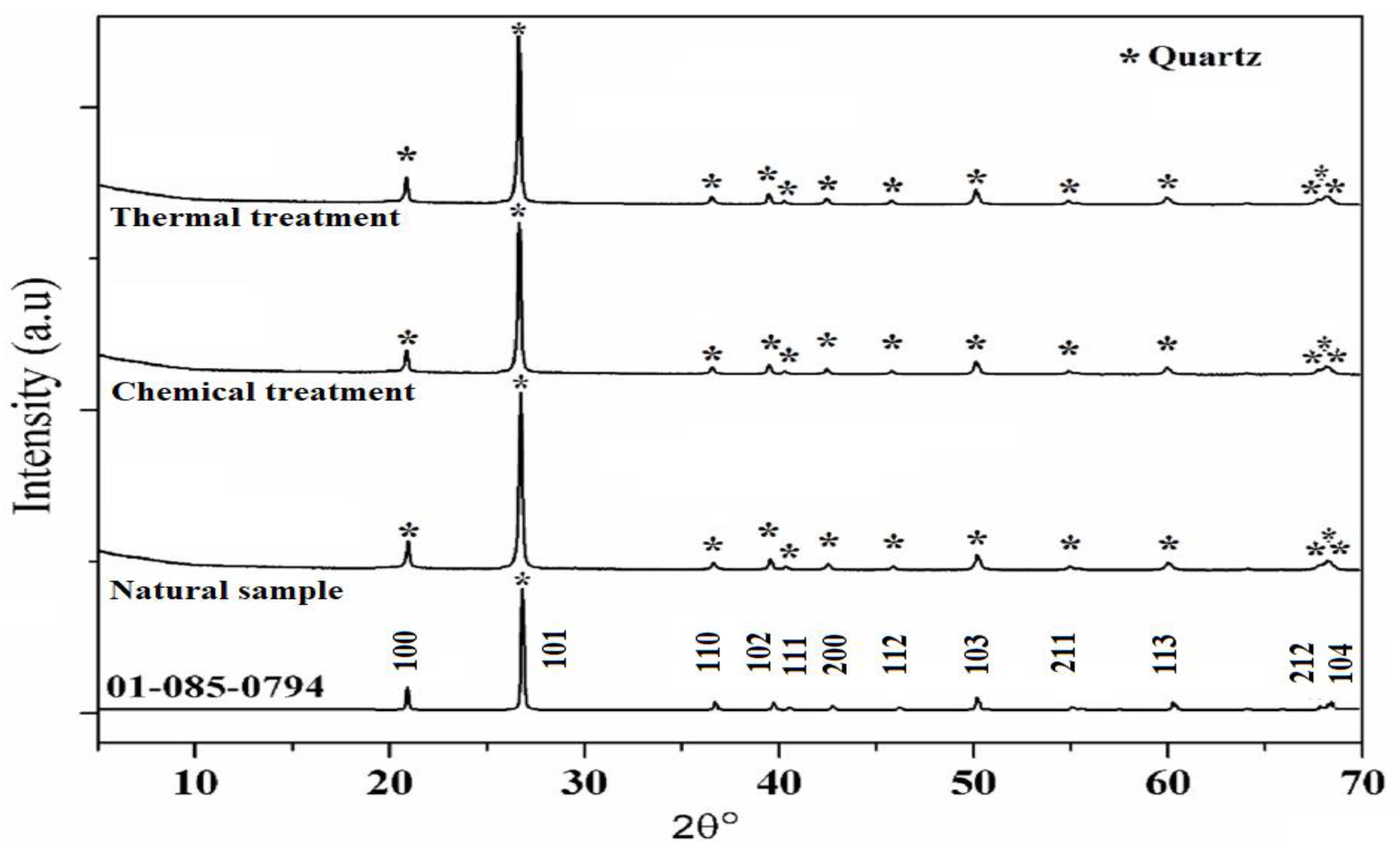
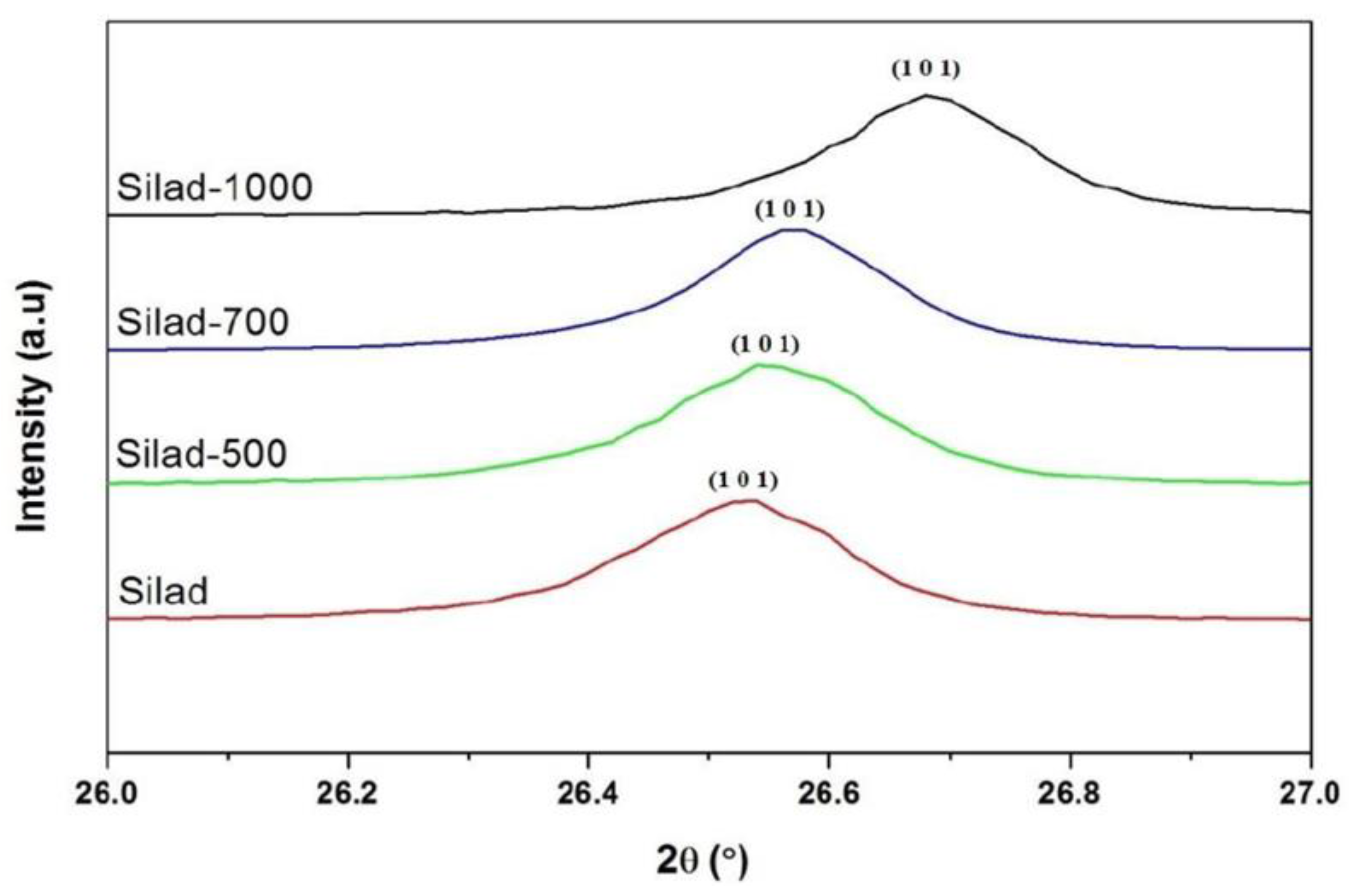

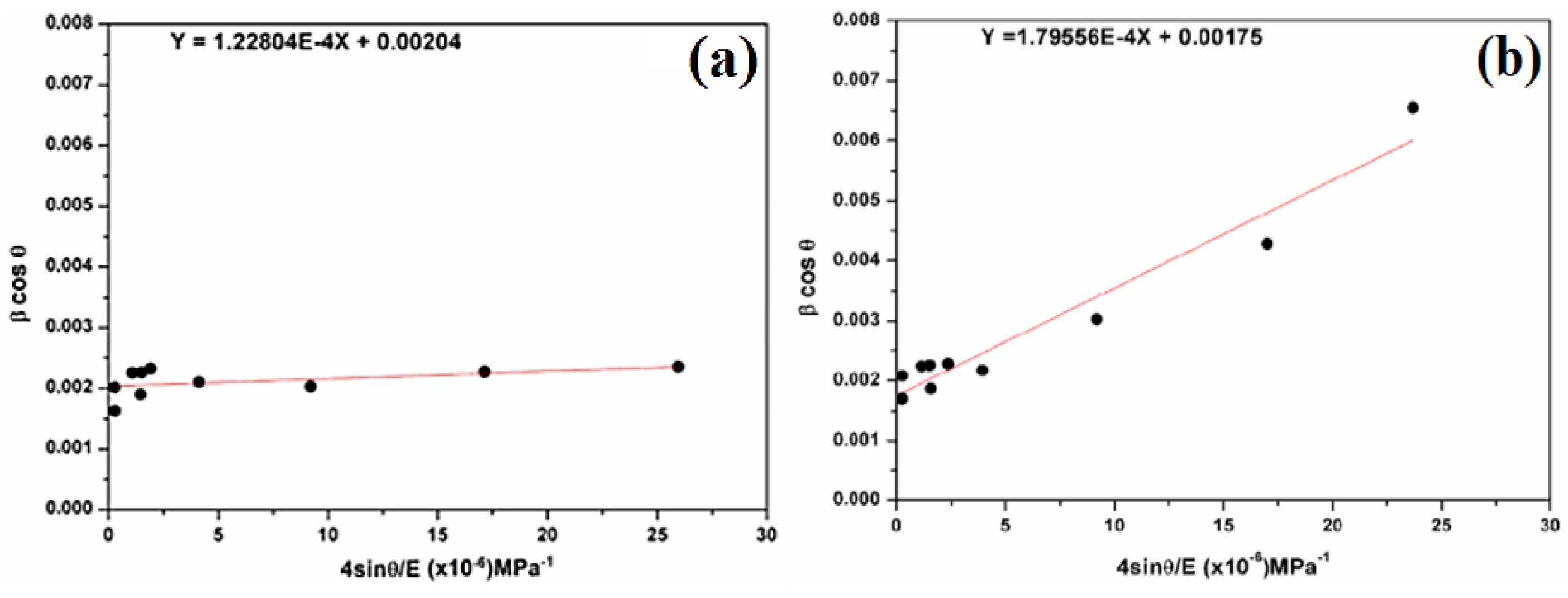
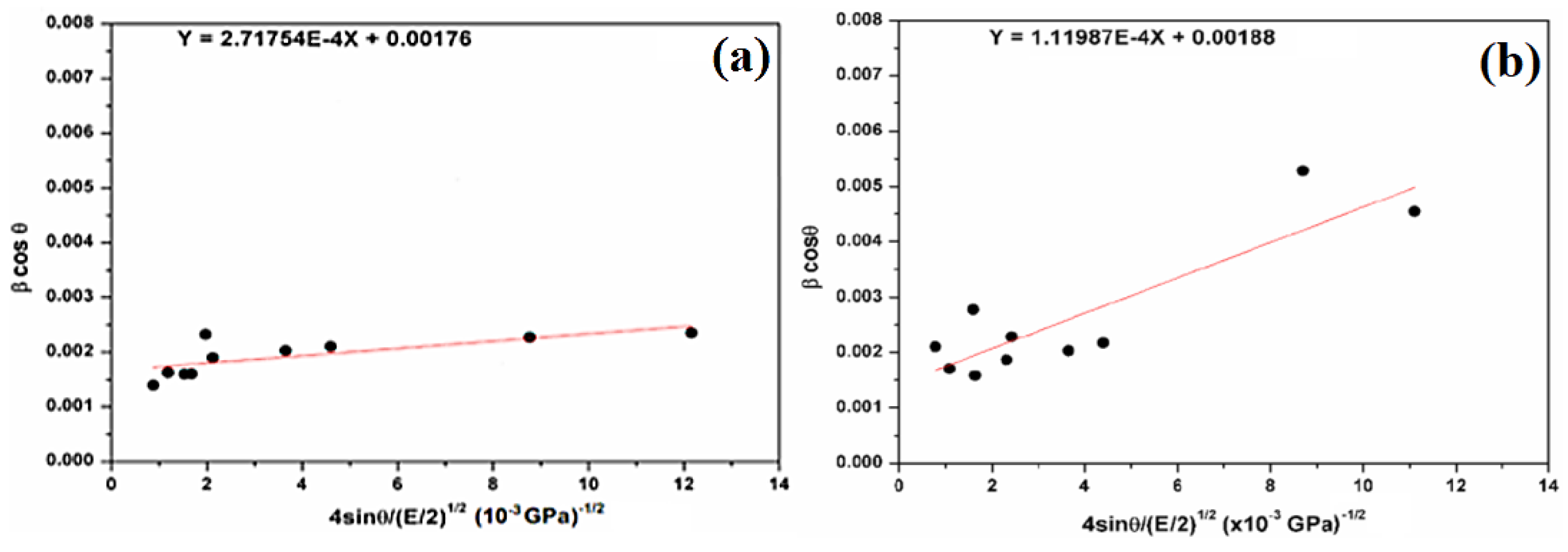
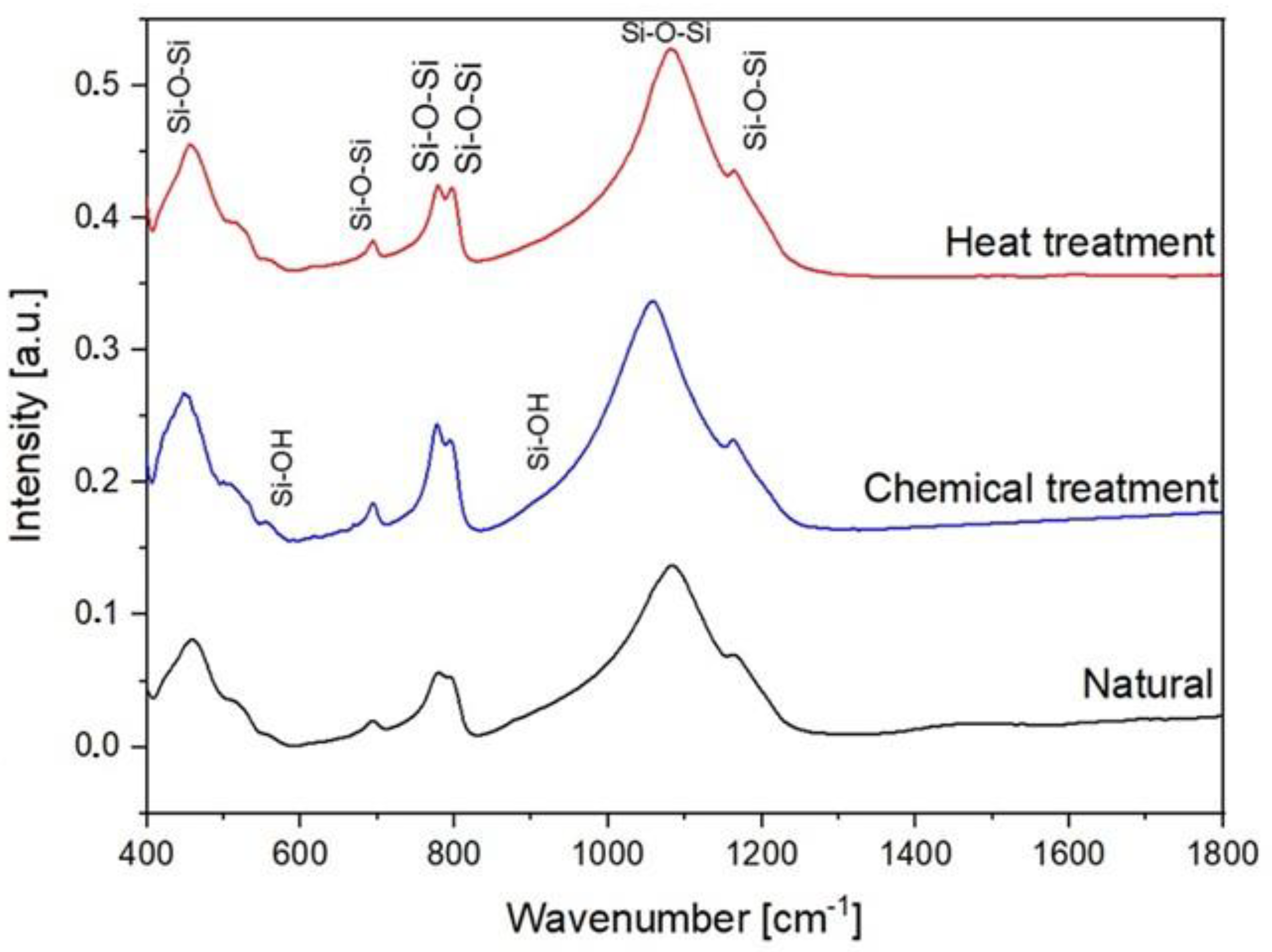

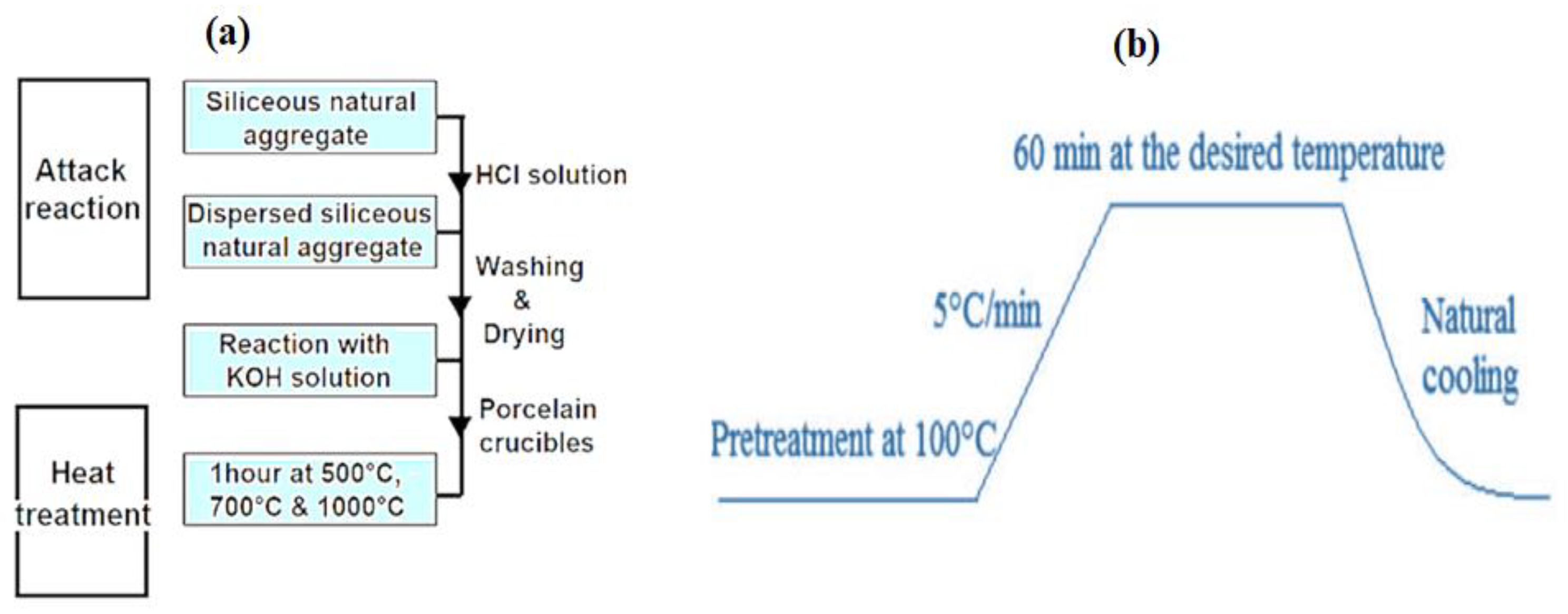
| Samples | Structure | FWHM (101) | Lattice Parameter | |||
|---|---|---|---|---|---|---|
| a = b (Ǻ) | c (Ǻ) | Lattice Volume (Ǻ3) | ||||
| Natural sample | Hexagonal | 0.1968 | 4.92937 ± 0.00009 | 5.47631 ± 0.00018 | 115.1829 ± 0.0048 | |
| Chemical treatment | 0.1574 | 4.89835 ± 0.00009 | 5.38702 ± 0.00018 | 111.9401 ± 0.0048 | ||
| Thermal treatments | 500 °C | 0.1771 | 4.69494 ± 0.00015 | 5.47950 ± 0.00028 | 104.6002 ± 0.0065 | |
| 700 °C | 0.1474 | 4.69165 ± 0.00014 | 5.47826 ± 0.00028 | 104.4297 ± 0.0065 | ||
| 1000 °C | 0.1378 | 4.42348 ± 0.00013 | 4.95383 ± 0.00023 | 83.9459 ± 0.0054 | ||
Disclaimer/Publisher’s Note: The statements, opinions and data contained in all publications are solely those of the individual author(s) and contributor(s) and not of MDPI and/or the editor(s). MDPI and/or the editor(s) disclaim responsibility for any injury to people or property resulting from any ideas, methods, instructions or products referred to in the content. |
© 2024 by the authors. Licensee MDPI, Basel, Switzerland. This article is an open access article distributed under the terms and conditions of the Creative Commons Attribution (CC BY) license (https://creativecommons.org/licenses/by/4.0/).
Share and Cite
Khouchaf, L.; Oufakir, A. Relationship Between Elastic, Chemical, and Thermal Properties of SiO2 Flint Aggregate. Molecules 2024, 29, 5898. https://doi.org/10.3390/molecules29245898
Khouchaf L, Oufakir A. Relationship Between Elastic, Chemical, and Thermal Properties of SiO2 Flint Aggregate. Molecules. 2024; 29(24):5898. https://doi.org/10.3390/molecules29245898
Chicago/Turabian StyleKhouchaf, Lahcen, and Abdelhamid Oufakir. 2024. "Relationship Between Elastic, Chemical, and Thermal Properties of SiO2 Flint Aggregate" Molecules 29, no. 24: 5898. https://doi.org/10.3390/molecules29245898
APA StyleKhouchaf, L., & Oufakir, A. (2024). Relationship Between Elastic, Chemical, and Thermal Properties of SiO2 Flint Aggregate. Molecules, 29(24), 5898. https://doi.org/10.3390/molecules29245898





